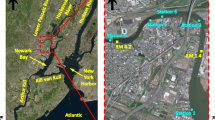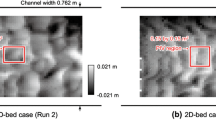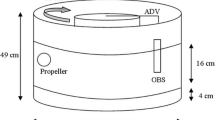Abstract
In order to model the transport of cohesive sediments and associated contaminants accurately, knowledge of erosion rates is indispensable; at present, these are mostly obtained from the literature and usually extended by field data. In contrast to these theoretical approaches we have developed a method to determine erosion rates directly from experiments conducted with undisturbed sediment cores in a laboratory flume. Regularly spaced laser lines are projected onto the sediment surface during the erosion process. To compute the volume loss over a certain period of time, snapshots of the projected lines are taken and the relation between the deformed projected lines and the sediment surface is derived. With this relation and bilinear interpolation, the sediment surface is reconstructed. The volume difference between the reconstructed sediment surfaces corresponding to the snapshots is then calculated. Consequently, volume loss can be determined in mm3 per time with a maximum error of 7.2%. The average error is less than 1%. Combination with the bulk density results in erosion rates in kg m−1 s−1. The high sensitivity of the laser lines to sediment surface changes allows the determination of even small erosion rates. Thus, it is possible to determine erosion rates directly as a function of shear stress. Since it is possible to vary the area of calculated sediment-volume loss, scaling effects can be investigated as well.
Similar content being viewed by others
References
Dreher, T., 1997. Non intrusive measurement of particle concentration and experimental characterization of sedimentation. Stuttgart, Sonderforschungsbereich 404, Universität Stuttgart.
Kern, U., I. Haag, V. Schürlein, M. Holzwarth & B. Westrich, 1999. Ein Strömungskanal zur Ermittlung der tiefenabhängigen Erosionsstabilität von Gewässersedimenten: das SETEG-System. Wasserwirtschaft 89: 72-77.
Lick, W. & J. McNeil, 2001. Effects of sediment bulk properties on erosion rates. Sci. Tot. Environ. 266: 41-48.
McNeil, J., C. Taylor & W. Lick, 1996. Measurements of erosion of undisturbed bottom sediments with depth. J. Hydraul. Eng. 122: 316-324.
Westrich, B. & O. Witt, 2000. Critical erosion shear stress profiling for undisturbed cohesive sediment cores. INTERCOH 2000-05-16 - 6th International Conference on Nearshore and Estuarine Cohesive Sediment Transport Processes, Delft.
Westrich, B. & U. Kern, 1999. Das Erosionsverhalten kohäsiver Gewässersedimente: AAbhängigkeit von physikalischen, chemischen und biologischen Einflußfaktoren. Institut für Wasserbau. Stuttgart, Universität Stuttgart: 25 pp.
Author information
Authors and Affiliations
Rights and permissions
About this article
Cite this article
Witt, O., Westrich, B. Quantification of erosion rates for undisturbed contaminated cohesive sediment cores by image analysis. Hydrobiologia 494, 271–276 (2003). https://doi.org/10.1023/A:1025495122246
Issue Date:
DOI: https://doi.org/10.1023/A:1025495122246




